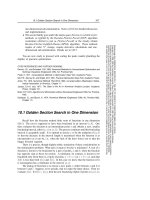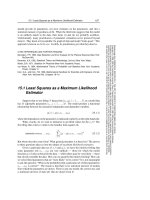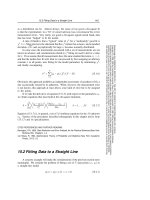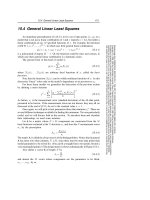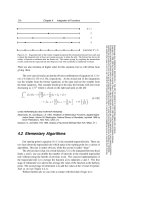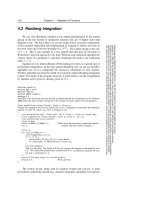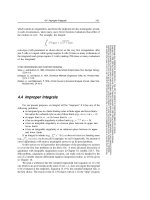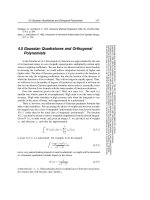Tài liệu Evaluation of Functions part 2 doc
Bạn đang xem bản rút gọn của tài liệu. Xem và tải ngay bản đầy đủ của tài liệu tại đây (127.83 KB, 5 trang )
Sample page from NUMERICAL RECIPES IN C: THE ART OF SCIENTIFIC COMPUTING (ISBN 0-521-43108-5)
Copyright (C) 1988-1992 by Cambridge University Press.Programs Copyright (C) 1988-1992 by Numerical Recipes Software.
Permission is granted for internet users to make one paper copy for their own personal use. Further reproduction, or any copying of machine-
readable files (including this one) to any servercomputer, is strictly prohibited. To order Numerical Recipes books,diskettes, or CDROMs
visit website or call 1-800-872-7423 (North America only),or send email to (outside North America).
Chapter 5. Evaluation of Functions
5.0 Introduction
The purpose of this chapter is to acquaint you with a selection of the techniques
that are frequently used in evaluating functions. In Chapter 6, we will apply and
illustrate these techniques by giving routines for a variety of specific functions.
The purposes of this chapter and the next are thus mostly in harmony, but there
is nevertheless some tension between them: Routines that are clearest and most
illustrative of the general techniques of this chapter are not always the methods of
choice for a particular special function. By comparing this chapter to the next one,
you should get some idea of the balance between “general” and “special” methods
that occurs in practice.
Insofar as that balance favors general methods, this chapter should give you
ideas about how to write your own routine for the evaluation of a function which,
while “special” to you, is not so special as to be included in Chapter 6 or the
standard program libraries.
CITED REFERENCES AND FURTHER READING:
Fike, C.T. 1968,
Computer Evaluation of Mathematical Functions
(Englewood Cliffs, NJ:Prentice-
Hall).
Lanczos, C. 1956,
Applied Analysis
; reprinted 1988 (New York: Dover), Chapter 7.
5.1 Series and Their Convergence
Everybodyknows thatan analytic functioncan be expanded inthe neighborhood
of a point x
0
in a power series,
f(x)=
∞
k=0
a
k
(x − x
0
)
k
(5.1.1)
Such series are straightforward to evaluate. You don’t, of course, evaluate the kth
power of x −x
0
ab initio for each term; rather you keep the k − 1st power and update
it with a multiply. Similarly, the form of the coefficients a is often such as to make
use of previous work: Terms like k! or (2k)! can be updated in a multiply or two.
165
166
Chapter 5. Evaluation of Functions
Sample page from NUMERICAL RECIPES IN C: THE ART OF SCIENTIFIC COMPUTING (ISBN 0-521-43108-5)
Copyright (C) 1988-1992 by Cambridge University Press.Programs Copyright (C) 1988-1992 by Numerical Recipes Software.
Permission is granted for internet users to make one paper copy for their own personal use. Further reproduction, or any copying of machine-
readable files (including this one) to any servercomputer, is strictly prohibited. To order Numerical Recipes books,diskettes, or CDROMs
visit website or call 1-800-872-7423 (North America only),or send email to (outside North America).
How do you know when you have summed enough terms? In practice, the
terms had better be getting small fast, otherwise the series is not a good technique
to use in the first place. While not mathematically rigorous in all cases, standard
practice is to quit when the term you have just added is smaller in magnitude than
some small times the magnitude of the sum thus far accumulated. (But watch out
if isolated instances of a
k
=0are possible!).
A weakness of a power series representation is that it is guaranteed not to
converge farther than that distance from x
0
at which a singularity is encountered
in the complex plane. This catastrophe is not usually unexpected: When you find
a power series in a book (or when you work one out yourself), you will generally
also know the radius of convergence. An insidious problem occurs with series that
converge everywhere (in the mathematical sense), but almost nowhere fast enough
to be useful in a numerical method. Two familiar examples are the sine function
and the Bessel function of the first kind,
sin x =
∞
k=0
(−1)
k
(2k +1)!
x
2k+1
(5.1.2)
J
n
(x)=
x
2
n
∞
k=0
(−
1
4
x
2
)
k
k!(k + n)!
(5.1.3)
Both of these series converge for all x. But both don’t even start to converge
until k |x|; before this, their terms are increasing. This makes these series
useless for large x.
Accelerating the Convergence of Series
There are several tricks for accelerating the rate of convergence of a series (or,
equivalently, of a sequence of partial sums). These tricks will not generally help in
cases like (5.1.2) or (5.1.3) while the size of the terms is still increasing. For series
with terms of decreasing magnitude, however, some accelerating methods can be
startlingly good. Aitken’s δ
2
-process is simply a formula for extrapolatingthe partial
sums of a series whose convergence is approximately geometric. If S
n−1
,S
n
,S
n+1
are three successive partial sums, then an improved estimate is
S
n
≡ S
n+1
−
(S
n+1
− S
n
)
2
S
n+1
− 2S
n
+ S
n−1
(5.1.4)
You can also use (5.1.4) with n +1and n − 1 replaced by n + p and n − p
respectively, for any integer p. If you form the sequence of S
i
’s, you can apply
(5.1.4) a second time to that sequence, and so on. (In practice, this iteration will
only rarely do much for you after the first stage.) Note that equation (5.1.4) should
be computed as written; there exist algebraically equivalent forms that are much
more susceptible to roundoff error.
For alternating series (where the terms in the sum alternate in sign), Euler’s
transformation can be a powerful tool. Generally it is advisable to do a small
5.1 Series and Their Convergence
167
Sample page from NUMERICAL RECIPES IN C: THE ART OF SCIENTIFIC COMPUTING (ISBN 0-521-43108-5)
Copyright (C) 1988-1992 by Cambridge University Press.Programs Copyright (C) 1988-1992 by Numerical Recipes Software.
Permission is granted for internet users to make one paper copy for their own personal use. Further reproduction, or any copying of machine-
readable files (including this one) to any servercomputer, is strictly prohibited. To order Numerical Recipes books,diskettes, or CDROMs
visit website or call 1-800-872-7423 (North America only),or send email to (outside North America).
number n − 1 of terms directly, then apply the transformation to the rest of the series
beginning with the nth term. The formula (for n even) is
∞
s=0
(−1)
s
u
s
= u
0
− u
1
+ u
2
...−u
n−1
+
∞
s=0
(−1)
s
2
s+1
[∆
s
u
n
](5.1.5)
Here ∆ is the forward difference operator, i.e.,
∆u
n
≡ u
n+1
− u
n
∆
2
u
n
≡ u
n+2
− 2u
n+1
+ u
n
∆
3
u
n
≡ u
n+3
− 3u
n+2
+3u
n+1
− u
n
etc.
(5.1.6)
Of course you don’t actually do the infinite sum on the right-hand side of (5.1.5),
but only the first, say, p terms, thus requiring the first p differences (5.1.6) obtained
from the terms starting at u
n
.
Euler’s transformation can be applied not only to convergent series. In some
cases it will produce accurate answers from the first terms of a series that is formally
divergent. It is widely used in the summation of asymptotic series. In this case
it is generally wise not to sum farther than where the terms start increasing in
magnitude; and you should devise some independent numerical check that the results
are meaningful.
There is an elegant and subtle implementation of Euler’s transformation due
to van Wijngaarden
[1]
: It incorporates the terms of the original alternating series
one at a time, in order. For each incorporation it either increases p by 1, equivalent
to computing one further difference (5.1.6), or else retroactively increases n by 1,
without having to redo all the difference calculations based on the old n value! The
decision as to which to increase, n or p, is taken in such a way as to make the
convergence most rapid. Van Wijngaarden’s technique requires only one vector of
saved partial differences. Here is the algorithm:
#include <math.h>
void eulsum(float *sum, float term, int jterm, float wksp[])
Incorporates into
sum
the
jterm
’th term, with value
term
, of an alternating series.
sum
is
input as the previous partial sum, and is output as the new partial sum. The first call to this
routine, with the first
term
in the series, should be with
jterm=1
. On the second call,
term
should be set to the second term of the series, with sign opposite to that of the first call, and
jterm
should be 2. And so on.
wksp
is a workspace array provided by the calling program,
dimensioned at least as large as the maximum number of terms to be incorporated.
{
int j;
static int nterm;
float tmp,dum;
if (jterm == 1) { Initialize:
nterm=1; Number of saved differences in wksp.
*sum=0.5*(wksp[1]=term); Return first estimate.
} else {
tmp=wksp[1];
wksp[1]=term;
for (j=1;j<=nterm-1;j++) { Update saved quantities by van Wijn-
gaarden’s algorithm.dum=wksp[j+1];
168
Chapter 5. Evaluation of Functions
Sample page from NUMERICAL RECIPES IN C: THE ART OF SCIENTIFIC COMPUTING (ISBN 0-521-43108-5)
Copyright (C) 1988-1992 by Cambridge University Press.Programs Copyright (C) 1988-1992 by Numerical Recipes Software.
Permission is granted for internet users to make one paper copy for their own personal use. Further reproduction, or any copying of machine-
readable files (including this one) to any servercomputer, is strictly prohibited. To order Numerical Recipes books,diskettes, or CDROMs
visit website or call 1-800-872-7423 (North America only),or send email to (outside North America).
wksp[j+1]=0.5*(wksp[j]+tmp);
tmp=dum;
}
wksp[nterm+1]=0.5*(wksp[nterm]+tmp);
if (fabs(wksp[nterm+1]) <= fabs(wksp[nterm])) Favorable to increase p,
*sum += (0.5*wksp[++nterm]); and the table becomes longer.
else Favorable to increase n,
*sum += wksp[nterm+1]; the table doesn’t become longer.
}
}
The powerful Euler technique is not directly applicable to a series of positive
terms. Occasionally it is useful to convert a seriesof positiveterms intoan alternating
series, just so that the Euler transformation can be used! Van Wijngaarden has given
a transformation for accomplishing this
[1]
:
∞
r=1
v
r
=
∞
r=1
(−1)
r−1
w
r
(5.1.7)
where
w
r
≡ v
r
+2v
2r
+4v
4r
+8v
8r
+··· (5.1.8)
Equations (5.1.7) and (5.1.8) replace a simple sum by a two-dimensional sum, each
term in (5.1.7) being itself an infinite sum (5.1.8). This may seem a strange way to
save on work! Since, however, the indices in (5.1.8) increase tremendously rapidly,
as powers of 2, it often requires only a few terms to converge (5.1.8) to extraordinary
accuracy. You do, however, need to be able to compute the v
r
’s efficiently for
“random” values r. The standard “updating” tricks for sequential r’s, mentioned
above following equation (5.1.1), can’t be used.
Actually, Euler’s transformation is a special case of a more general transforma-
tion of power series. Suppose that some known function g(z) has the series
g(z)=
∞
n=0
b
n
z
n
(5.1.9)
and that you want to sum the new, unknown, series
f(z)=
∞
n=0
c
n
b
n
z
n
(5.1.10)
Then it is not hard to show (see
[2]
) that equation (5.1.10) can be written as
f(z)=
∞
n=0
[∆
(n)
c
0
]
g
(n)
n!
z
n
(5.1.11)
which often converges much more rapidly. Here ∆
(n)
c
0
is the nth finite-difference
operator (equation 5.1.6), with ∆
(0)
c
0
≡ c
0
,andg
(n)
is the nth derivative of g(z).
The usual Euler transformation (equation 5.1.5 with n =0) can be obtained, for
example, by substituting
g(z)=
1
1+z
=1−z+z
2
−z
3
+··· (5.1.12)
5.2 Evaluation of Continued Fractions
169
Sample page from NUMERICAL RECIPES IN C: THE ART OF SCIENTIFIC COMPUTING (ISBN 0-521-43108-5)
Copyright (C) 1988-1992 by Cambridge University Press.Programs Copyright (C) 1988-1992 by Numerical Recipes Software.
Permission is granted for internet users to make one paper copy for their own personal use. Further reproduction, or any copying of machine-
readable files (including this one) to any servercomputer, is strictly prohibited. To order Numerical Recipes books,diskettes, or CDROMs
visit website or call 1-800-872-7423 (North America only),or send email to (outside North America).
into equation (5.1.11), and then setting z =1.
Sometimes you will want to compute a function from a series representation
even when the computation is not efficient. Forexample, you may be usingthe values
obtained to fit the function to an approximating form that you will use subsequently
(cf. §5.8). If you are summing very large numbers of slowly convergent terms, pay
attention to roundoff errors! In floating-point representation it is more accurate to
sum a list of numbers in the order starting with the smallest one, rather than starting
with the largest one. It is even better to group terms pairwise, then in pairs of pairs,
etc., so that all additions involve operands of comparable magnitude.
CITED REFERENCES AND FURTHER READING:
Goodwin, E.T. (ed.) 1961,
Modern Computing Methods
, 2nd ed. (New York: Philosophical Li-
brary), Chapter 13 [van Wijngaarden’s transformations]. [1]
Dahlquist, G., and Bjorck, A. 1974,
Numerical Methods
(Englewood Cliffs, NJ: Prentice-Hall),
Chapter 3.
Abramowitz, M., and Stegun, I.A. 1964,
Handbook of Mathematical Functions
, Applied Mathe-
matics Series, Volume 55 (Washington: National Bureau of Standards; reprinted 1968 by
Dover Publications, New York),
§
3.6.
Mathews, J., and Walker, R.L. 1970,
Mathematical Methods of Physics
, 2nd ed. (Reading, MA:
W.A. Benjamin/Addison-Wesley),
§
2.3. [2]
5.2 Evaluation of Continued Fractions
Continued fractions are often powerful ways of evaluating functions that occur
in scientific applications. A continued fraction looks like this:
f(x)=b
0
+
a
1
b
1
+
a
2
b
2
+
a
3
b
3
+
a
4
b
4
+
a
5
b
5
+···
(5.2.1)
Printers prefer to write this as
f(x)=b
0
+
a
1
b
1
+
a
2
b
2
+
a
3
b
3
+
a
4
b
4
+
a
5
b
5
+
··· (5.2.2)
In either (5.2.1) or (5.2.2), the a’s and b’s can themselves be functions of x, usually
linear or quadratic monomials at worst (i.e., constants times x or times x
2
). For
example, the continued fraction representation of the tangent function is
tan x =
x
1 −
x
2
3 −
x
2
5 −
x
2
7 −
··· (5.2.3)
Continued fractions frequently converge much more rapidly than power series
expansions, and in a much larger domain in the complex plane (not necessarily
including the domain of convergence of the series, however). Sometimes the
continued fraction converges best where the series does worst, although this is not


